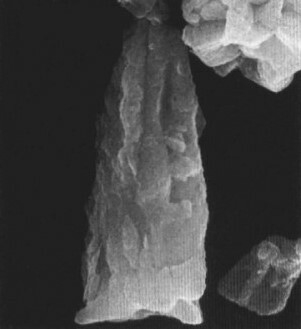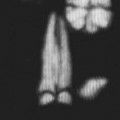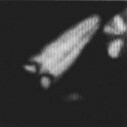Furcatolithus akropodus
Set number: 830
-
1
-
2
-
3
-
4
10µm
Sphenolithus akropodus de Kaenel & Villa, 1996
Large [7.0-11.0µm] species of furcatolith have a massive compound apical spine and a hollow frustum shape proximal cycle. The lateral cycle is not present. The apical spine is made up of several longitudinal blades with or without short bifurcation. The apical spine initially tapers gently or indistinctly from the base but starts tapering distinctly about midway. In the light microscope, in the axial section, the segments of the proximal cycle resemble "feet". The opposite side of the proximal cycle is better seen at 45° and display an axial c-axis. The base of the apical spine can be almost flat or conical with an obtuse or acute angle.
In cross-polarised light, the compound apical spine with axial c-axis shows maximum birefringence at 45° but extinct (dim) at 0° [the median blade of the apical spine is better seen from its keel at this orientation].
Furcatolithus akropodus differs from Furcatolithus distentus Martini, 1965 by being large and having a massive apical spine start tapering distinctly midway of its length. In contrast, the latter species is smaller, and its apical spine starts tapering distinctly from the base.
de Kaenel, E. & Villa, G. 1996. Oligocene-Miocene calcareous nannofossil biostratigraphy and paleoeecology from the Iberian Abyssal Plain. Proceedings of the Ocean Drilling Program, Scientific Results 149: 79-145.
Howe, R., 2021. Ultrastructure and taxonomy of the family Sphenolithaceae. Journal of Nannoplankton Research 39(1), 29-75.
Martini, E. 1965. Mid-Tertiary calcareous nannoplankton from Pacific deep-sea cores. Colston Papers 17: 393-411.



